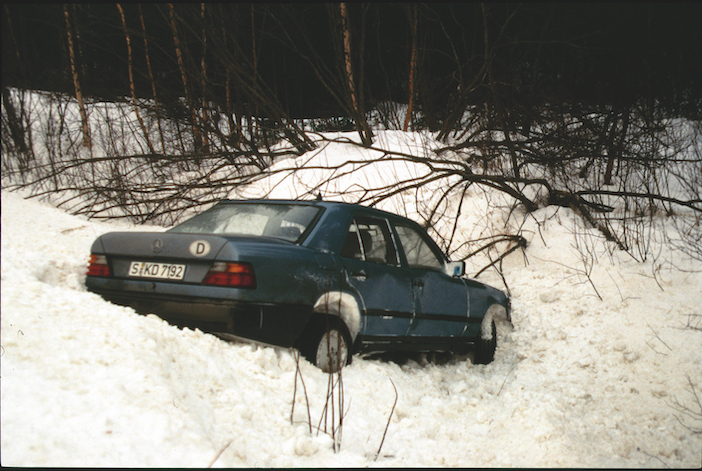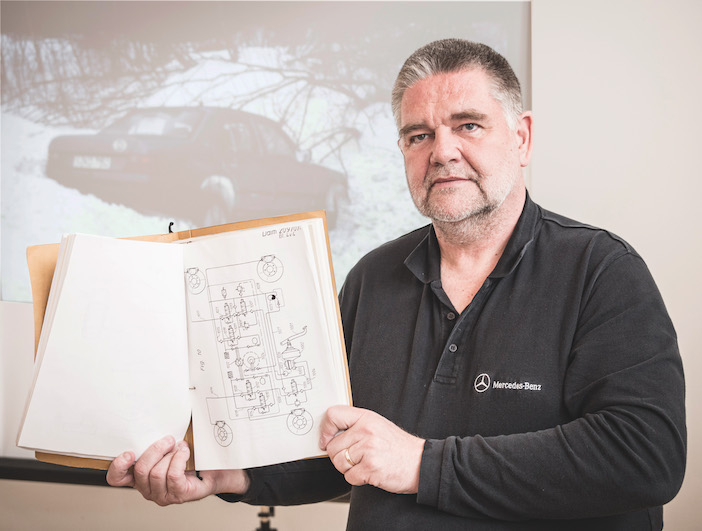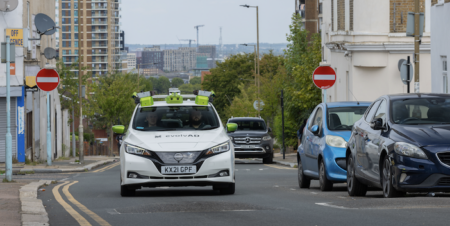Electronic stability control (ESC) is taken for granted today. Now fitted to millions of cars globally, it is recognised as the biggest advancement in vehicle safety since the seatbelt. But few know that the idea itself came about literally by accident, and that the patents for the technology were given free to suppliers – just as Volvo gave away its rights to the three-point seatbelt in the 1960s and didn’t charge other manufacturers one cent for its use.
Mercedes-Benz initially gave away the intellectual property of ESC to numerous suppliers to expedite the rollout of the technology and dramatically reduce its cost. But it had the net effect of saving countless lives; the hidden safety net working in the background without motorists even realising it.
It was February 1989 when a young Mercedes engineer, Frank Werner-Mohn, first came up with the idea of ESC, while sitting in a ditch after skidding off an icy road in the remote far north of Sweden. He and his colleagues in a convoy of W124 Mercedes-Benzes were doing some validation testing for a model-year change. Anti-lock brakes were still a relatively new technology and, as readers of this magazine will know, icy roads are ideal for testing such systems.

Given that cell phones were still an emerging technology, it took some time to summon help from a tow truck in the nearby town. It was while waiting in sub-zero temperatures for his car to be plucked from the snow that Werner-Mohn had the idea, as he relived the incident in his head over and over, wondering how he ended up such a spot.
“I was very embarrassed. I made a mistake, but how did this happen,” recalls Werner-Mohn. “But I feel I did not do anything wrong. It was a straight road, the car hit ice and I skidded off the road. Luckily for me, I did not hit a tree.”
Werner-Mohn then wondered what would happen if a gyro sensor could be fitted to the car, to detect a skid by somehow linking it to the steering sensor and wheel sensors.
Could the car then apply the brakes individually – using the then-new anti-lock brake system – to prevent a skid or, at the very least, minimise the yaw movement of the car?
It sounds straightforward now, but back then it was a revelation.
Putting theory into practice
Once back at headquarters in Stuttgart, Germany, Werner-Mohn and a small group of his engineering colleagues were given permission to build a prototype to test their theory.
Some engineering colleagues outside his inner circle originally mocked the idea, because it required so many parts of the car to ‘talk’ to each other.
Indeed, Werner-Mohn attributes the success of the programme to his boss giving him and his small team 12 months to test and/or prove the theory. “I am grateful for this because we could go away and experiment and prove this could work,” says Werner-Mohn. “Without this brave move by management to allow us to explore this idea that some people thought was crazy, we might not have invented it.”
The first challenge was to find a gyro sensor that could measure sideways movement. So they went to a toy shop and bought a remote-control model helicopter – and then dismantled it to get what was at the time a relatively precious part, the gyro sensor.
Eventually they proved the theory could work, albeit in a clunky fashion, and they quickly discovered they needed a gyro sensor with faster processing speeds. So they then sourced one from a scud missile – minus the warhead of course – to make a more durable prototype for the test car. With a much faster processing gyro sensor the system could be finessed. Cost was still an issue, of course, but this could be resolved later.
Management allowed the project to continue another 12 months because they could see that progress was being made. In March 1991 – after two years of intensive development – the technology was given the green light to go into production. The decision came quickly, after one of the top Mercedes executives, who was known to be timid behind the wheel, was almost as fast as the company’s professional test drivers around an ice lake obstacle course.
With the technology switched off, the novice barely made it past the first turn without skidding off course. But with the ESC technology active, he was able to complete the course almost as quickly, but more importantly he drove more confidently.
“Once they saw this technology could safely prevent a skid while taking a corner, the board approved it at once,” says Werner-Mohn. “At the time this was a revelation.”

A meeting of minds
Mercedes still had the issue of cost to overcome. It did not want to manufacture the technology, so it figured the best solution was to offer it to suppliers who could mass-produce it. Mercedes would get it first, but then allow suppliers to sell it to rival brands after an initial period of exclusivity.
Werner-Mohn tells the story of senior Mercedes engineering executives having a catch-up in Sweden the night before they were about to show Bosch engineers their new invention.
“I have an invention that your company does not have,” one Benz executive boasted to a counterpart at Bosch, querying why the long-standing supplier had not thought of a similar idea earlier.
In fact, Bosch was close to coming up with ESC as well. By pure coincidence, a small team of Bosch engineers were also working with the idea of gyro sensors, wheel sensors and anti-lock brakes to tame a car.
However, the Bosch system was only designed to work once the brakes were applied in an emergency stop, to prevent a skid as part of the ABS system.
The genius behind Werner-Mohn’s invention was that his ESC system monitored car behaviour all the time, even when the brakes weren’t applied. It was this critical difference that made Werner-Mohn’s design such a piece of life-saving technology. And why his name is on the patents that Mercedes filed.
The next day, Mercedes demonstrated its ESC system on ice to colleagues at Bosch, and both giants of the automotive industry realised what they had in front of them.
Elk and safety
Originally the technology was installed in Mercedes’ S-Class flagship limousine in 1995, but Mercedes wanted Bosch to take over responsibility for producing the technology at a more affordable level.
But then another twist of fate happened. In 1997 Swedish technical magazine, Teknikens Varld, flipped Mercedes’ new A-Class hatchback during a swerve-and-avoid ‘moose test’. Mercedes responded by fitting its new stability control technology – previously reserved for its flagship model – to its cheapest car.
This forced the technology to be shared with more suppliers, to further reduce cost. All this had the net effect of making ESC affordable for all Benz models; over the coming decade it was eventually rolled out across the entire range… and on the cars of countless rivals.
“We thank the journalist that he did this because it expedited the roll-out of our technology,” says Werner-Mohn.
At the time, though, Werner-Mohn had mixed emotions about his invention being handed over. “In my heart I was wounded because it was my invention and it was given away,” he says. “But of course I now see the best decision was to make it available to everyone, to spread it out to all cars.”
Back to the scene of the spin
We shared a car with Werner-Mohn, trying to find the anonymous stretch of road that changed the course of car safety.
We meet at Arjeplog, the village not far from the Arctic Circle upon which the car industry descends each winter to test ESC and other systems on prototype cars. We head south west about 300km which, normally, would take about three hours. But because conditions are icy, the roads are narrow, and visibility is limited by the weather and the convoys of trucks throwing up spray, it takes us close to six hours to get there.
Finding the town was the easy part; finding the exact spot where the crash happened in 1989 would require help. The tree-lined roads in this part of Sweden all look the same.
Werner-Mohn finds the local tow company (there’s only one), but it has changed hands since he was plucked from the snow all those years ago.
But being a small town it didn’t take long to find Tommy Bjurstrom who, as a young lad, went to work with his dad that day to go and retrieve some fancy new Mercedes.

Tommy’s father has since passed away, but the photos we show him (of him and his dad recovering Werner-Mohn’s W124) trigger his memory of the incident. Through a mix of German, English and Swedish, he figures out we want to be taken to the exact same spot where the crash happened. We head south out of town about 4km and Tommy pulls over on the side of a long straight stretch of road. It could be anywhere in Sweden, so familiar is the scenery.
The road surface has clearly been resealed a few times since 1989, and the trees have been cleared further away from the roadside. But Tommy is adamant this is the place. The men get out of their cars and hug awkwardly in their large snow jackets. We explain to Tommy what that 1989 crash led to: the invention of ESC, which also happens to be standard equipment on his Volvo.
Werner-Mohn is moved; this is the first time he has been back to this place. He is still a little embarrassed about the crash, even after so many years. But without his fateful mishap, how many lives would not have been saved?

An even greater legacy

Frank Werner-Mohn retired at the end of 2017 after 35 years with Mercedes-Benz. His final project was working with his fellow engineers on an autonomous car technology that won’t be seen for years to come.
Indeed, the stability control that Werner-Mohn and his colleagues invented has formed the basis for future autonomous car technology. Without this technology it would impossible to control the car autonomously in an emergency.
As someone who loves driving, Werner-Mohn understands why some people may be concerned about control being taken away from the driver.
“The driver should always be in control but, as with stability control, there will be systems that keep you safe without the driver knowing,” he says.
“Without technology, we would not save as many lives as we have already today.”





